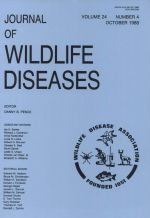One hundred fifty Amblyomma americanum were examined between March and September 1986 from Cookson Hills Wildlife Refuge in eastern Oklahoma (USA). Of these ticks, 11% (17 of 150) were infected with Theileria cervi. Field-collected nymphal ticks had an 8% (3 of 37) prevalence of infection averaging 1.0 infected acini/nymph. Female ticks had a 16% prevalence of infection averaging 1.6 infected acini/female; T. cervi was not observed in salivary glands of field-collected male ticks. When laboratory reared A. americanum nymphs were allowed to feed on experimental white-tailed deer (Odocoileus virginianus) with varying T. cervi parasitemias (<1, 2, 6 and >20%), only ticks which fed on deer with parasitemias >1% became infected. Although prevalence and intensity of infection varied in the infected ticks, there was no significant difference in prevalence of infection between males and females. However, females did acquire significantly greater intensities than males. The data from these studies confirm that T. cervi overwinters in A. americanum and suggests that the prevalence, intensity and abundance of infection of T. cervi in ticks is influenced by the parasitemia of the deer host. Furthermore, fawns may play a more important role in the epidemiology of T. cervi transmission than do adult deer because of the coordination between tick activity patterns and deer fawning.
How to translate text using browser tools
1 October 1988
SUSCEPTIBILITY OF AMBLYOMMA AMERICANUM TO NATURAL AND EXPERIMENTAL INFECTIONS WITH THEILERIA CERVI
J. Scott Laird,
A. Alan Kocan,
Katherine M. Kocan,
Steven M. Presley,
Jakie A. Hair

Journal of Wildlife Diseases
Vol. 24 • No. 4
October 1988
Vol. 24 • No. 4
October 1988
Amblyomma americanum
experimental infection
field study
Odocoileus virginianus
susceptibility
Theileria cervi
white-tailed deer




